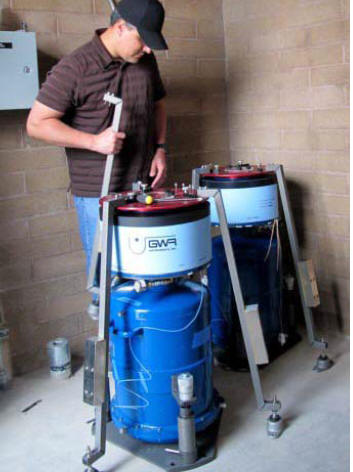GGP, Phase 1, ran
from 1 July 1997 to 1 July 2003. At the 2003 IUGG in Sapporo, GGP was
officially integrated into the IAG as an Intercommision Project,
reporting to Commission 3 (Earth Rotation and Geodynamics) and Commission 2 (The
Gravity Field). GGP completed Phase 2 at the IUGG in Perugia, Italy, 2007,
and will now continue indefinitely as an IAG Inter-Commission Project.
The purpose of GGP is twofold. Its
main objective is to record the Earth's gravity field with
high accuracy at a number of worldwide stations using superconducting gravimeters (SGs). Each site is
visited at least twice per year with an absolute gravimeter
to co-determine secular changes and check calibration. A list of publications related to GGP and SGs is available at
this site, as are a number of
newsletters published for the benefit of the
community.
The data is
used in an extensive set of studies
of the Earth, ranging from global motions of the whole
Earth such as the Chandler wobble to the surficial
gravity effects of atmospheric pressure and groundwater.
The SG stations are run independently by national groups
of scientists who send data each month to the GGP Data Centre at the International Centre for Earth
Tides (ICET) in Brussels. As of January 2008, ICET operations will be
transferred to Tahiti.
The second objective of GGP is to
maintain standards for the deployment of all GWR SGs, including site,
instrument, data acquisition, and processing guidelines for SG
instruments, as acknowledged by agreements between the SG groups. For some of the
GGP sites, the most recent data is temporarily restricted
and will become available one or two years after
collection. For other GGP sites, the data is available as
soon as it has been sent to ICET, without restriction.
Interested scientists can contact ICET, or the persons
below, for details. Useful site links and other related information about
gravimetry are also on this site.
For further
information, contact David Crossley (Chairman) at crossley@eas.slu.edu, or
Jacques Hinderer (Secretary) at Jacques.Hinderer@eost.u-strasbg.fr
This
Website, and the research described herein, is supported
jointly by funding from NSF
(National
Science Foundation,
USA) EAR
0409381 and CNRS
(Centre
National de la Recherche Scientifique, France).
|

